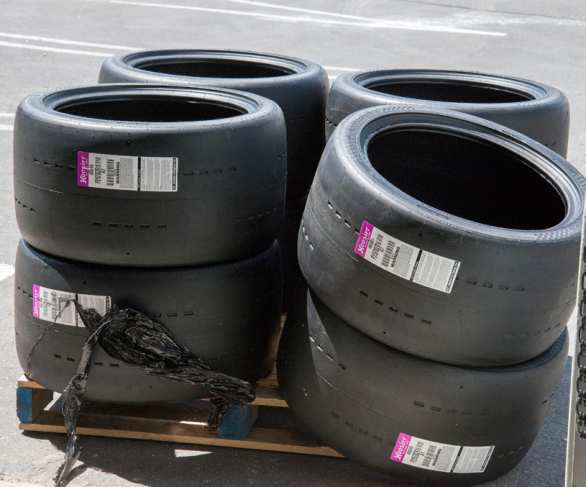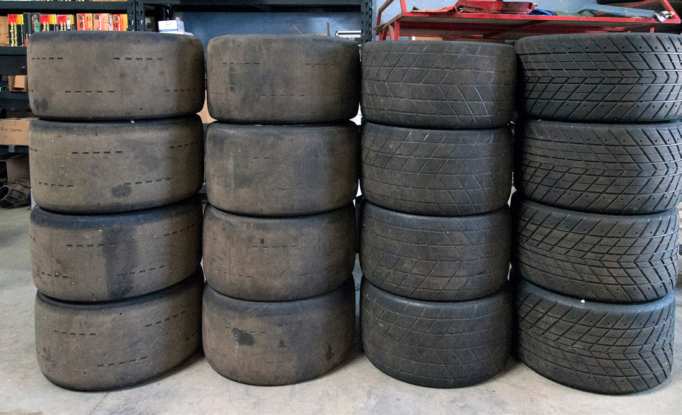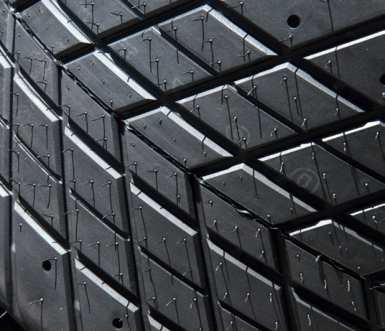Tires

Big Red has run on many different tires over the years. Dan had done a bunch of research, and was working with BFGoodrich in 1988 to get some road tires that would stand up to the punishment Big Red was going to deliver. BFG made short production runs of Comp T/A R-1 compound tires that worked well in the La Carrera Classica II and the Silver State Classic Challenge. Big Red was heavy and insanely fast, so Dan didn’t want RJ to be racing on regular tires. Tire technology wasn’t what it is today. Since then, tires have improved tremendously, and brands are different for each application. For Land
Speed, Big Red runs Mickey Thompson, Dunlop, and Goodyear. For Top Speed, it wears Hoosier. Road Race mode has used the biggest list of tires; BFGoodrich, Goodyear, Hoosier, and Michelin.
When Big Red runs a new record, or something notable happens, the guys usually mark the tires with chalk and set them aside. There’s a stack of tires in the office. This tire was marked, but didn’t make the cut and went to the office. The best we can make out from the chalk marks is that it’s a rear tire from the SCTA event held at Mojave forracers who were displaced due to poor salt conditions at Bonneville. This event was held at the Mojave Air and Space Port, on August 8-9, 2015. Big Red ran 230.3 mph with a few burned
pistons. The team trailered Big Red to the shop (luckily it was close by) and swapped the engine, working late into the night. The next day, RJ ran a 232.9 mph.
Running Pikes Peak was a big undertaking. Not only were there a few days of qualifying before the race, there were also multiple days of tire testing leading up to the race week. All those runs up the mountain equated to tire wear, so Mark ordered a pallet of Hoosier 315/30ZR18 DOT slicks. All four corners run the same size tires. The tire store must love it when they see Mark drive off in the shop truck full of tires and wheels. Mark inflated the tires with nitrogen-rich air rather than regular compressed air, which is approximately 78-percent nitrogen, 21 percent oxygen, and one percent water vapor. When filling tires with nitrogen, it’s actually “nitrogen-rich” air, which is approximately 93-percent nitrogen and seven percent air. Nitrogen keeps tire pressures more stable as tires get hot (from friction and rubber deformation), only because it doesn’t have water vapor. The water vapor is what heats up exponentially and causes tire-pressure fluctuation. Nitrogen also permeates through the rubber slower than oxygen, so it holds pressure longer.


Water under a racing slick disperses at a slow rate. Adding grooves to the face of the tire allows it to disperse water faster. Pikes Peak competitors are required to have at least one set of grooved tires in case of wet conditions, so the team had one set of Hoosier slicks “grooved” with treads. Tim laid out the tread pattern on the tire and had MJB, at MJB Chrome Plating in Rialto, California, cut the grooves in them. These tires were used a couple of times during Pikes Peak tire testing due to wet spots reported on the road. For full rain conditions and cool temperatures, the team bought a full set of P305/30R18 Hoosier H2O “Wets.” They wanted to be fully prepared for any weather condition at Pikes Peak. The Wets disperse water much faster than the grooved slicks. They were mounted on the car and tested for a few laps at Buttonwillow during early testing. They were mounted on Big Red one time at Pikes Peak during testing, but the threat of rain passed, so they were removed.